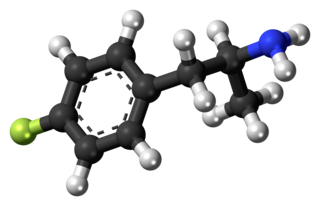Chloroamphetamine may refer to:
Chloroamphetamine may refer to:
PCA may refer to:
DOC, Doc, doc or DoC may refer to:

2,5-Dimethoxy-4-iodoamphetamine (DOI) is a psychedelic drug and a substituted amphetamine. Unlike many other substituted amphetamines, however, it is not primarily a stimulant. DOI has a stereocenter and R-(−)-DOI is the more active stereoisomer. In neuroscience research, [125I]-R-(−)-DOI is used as a radioligand and indicator of the presence of 5-HT2A serotonin receptors. DOI's effects have been compared to LSD, although there are differences that experienced users can distinguish. Besides the longer duration, the trip tends to be more energetic than an LSD trip, with more body load and a different subjective visual experience. The after effects include residual stimulation and difficulty sleeping, which, depending on the dose, may persist for days. While rare, it is sometimes sold as a substitute for LSD, or even sold falsely as LSD, which may be dangerous because DOI does not have the same established safety profile as LSD.

4-Fluoroamphetamine, also known as para-fluoroamphetamine (PFA) is a psychoactive research chemical of the phenethylamine and substituted amphetamine chemical classes. It produces stimulant and entactogenic effects. As a recreational drug, 4-FA is sometimes sold along with related compounds such as 2-fluoroamphetamine and 4-fluoromethamphetamine.

Fenclonine, also known as para-chlorophenylalanine (PCPA), acts as a selective and irreversible inhibitor of tryptophan hydroxylase, which is a rate-limiting enzyme in the biosynthesis of serotonin.
Article often refers to:

para-Chloroamphetamine (PCA), also known as 4-chloroamphetamine (4-CA), is a substituted amphetamine and monoamine releaser similar to MDMA, but with substantially higher activity as a monoaminergic neurotoxin, thought to be due to the unrestrained release of both serotonin and dopamine by a metabolite. It is used as a neurotoxin by neurobiologists to selectively kill serotonergic neurons for research purposes, in the same way that 6-hydroxydopamine is used to kill dopaminergic neurons.

5-Iodo-2-aminoindane (5-IAI) is a drug which acts as a releasing agent of serotonin, norepinephrine, and dopamine. It was developed in the 1990s by a team led by David E. Nichols at Purdue University. 5-IAI fully substitutes for MDMA in rodents and is a putative entactogen in humans. Unlike related aminoindane derivatives like MDAI and MMAI, 5-IAI causes some serotonergic neurotoxicity in rats, but is substantially less toxic than its corresponding amphetamine homologue pIA, with the damage observed barely reaching statistical significance.

para-Chlorophenylpiperazine (pCPP) is a psychoactive drug of the phenylpiperazine class. It is relatively obscure, with limited human use, and produces slightly psychedelic effects. It has been encountered in illicit capsules as a recreational drug similarly to other piperazines like mCPP. Scientific research has demonstrated pCPP to have serotonergic effects, likely acting as a non-selective serotonin receptor agonist and/or releasing agent.
The molecular formula C9H12ClN may refer to:

para-Bromoamphetamine (PBA), also known as 4-bromoamphetamine (4-BA), is an amphetamine derivative which acts as a serotonin-norepinephrine-dopamine releasing agent (SNDRA) and produces stimulant effects.

para-Iodoamphetamine (PIA), also known as 4-iodoamphetamine (4-IA), is a research chemical of the phenethylamine and amphetamine chemical classes.

6-Chloro-2-aminotetralin (6-CAT) is a drug which acts as a selective serotonin releasing agent (SSRA) and is a putative entactogen in humans. It is a rigid analogue of para-chloroamphetamine (PCA).

4-Chlorophenylisobutylamine, also known as 4-chloro-α-ethylphenethylamine, is an entactogen and stimulant drug of the phenethylamine class. It is an analogue of para-chloroamphetamine (PCA) where the alpha position methyl has been replaced with an ethyl group.

Iofetamine, brand names Perfusamine, SPECTamine), or N-isopropyl-(123I)-p-iodoamphetamine (IMP), is a lipid-soluble amine and radiopharmaceutical drug used in cerebral blood perfusion imaging with single-photon emission computed tomography (SPECT). Labeled with the radioactive isotope iodine-123, it is approved for use in the United States as a diagnostic aid in determining the localization of and in the evaluation of non-lacunar stroke and complex partial seizures, as well as in the early diagnosis of Alzheimer's disease.

3,4-Dichloroamphetamine (3,4-DCA), is an amphetamine derived drug invented by Eli Lilly in the 1960s, which has a number of pharmacological actions. It acts as a highly potent and selective serotonin releasing agent (SSRA) and binds to the serotonin transporter with high affinity, but also acts as a selective serotonergic neurotoxin in a similar manner to the related para-chloroamphetamine, though with slightly lower potency. It is also a monoamine oxidase inhibitor (MAOI), as well as a very potent inhibitor of the enzyme phenylethanolamine N-methyl transferase which normally functions to transform noradrenaline into adrenaline in the body.

para-Chloromethamphetamine is a stimulant that is the N-methyl derivative and prodrug of the neurotoxic drug para-chloroamphetamine (4-CA). It has been found to decrease serotonin in rats. Further investigation into the long-term effects of chloroamphetamines discovered that administration of 4-CMA caused a prolonged reduction in the levels of serotonin and the activity of tryptophan hydroxylase in the brain one month after injection of a single dose of the drug.

3-Chloromethamphetamine is a substituted amphetamine derivative invented in the 1960s. In animal studies it was deemed to be a "hallucinogen" rather than a stimulant, though the assays used at the time did not distinguish between the compounds now termed psychedelics and those now termed empathogens.

2,4-Dichloroamphetamine (2,4-DCA) is a psychostimulant of the amphetamine family and a potent serotonergic neurotoxin related to para-chloroamphetamine. It is also a potent monoamine oxidase inhibitor in addition to the aforementioned activities.

3-Chloroamphetamine (3-CA), also known as meta-chloroamphetamine, is a psychostimulant of the amphetamine family and a potent serotonergic neurotoxin related to para-chloroamphetamine (PCA).